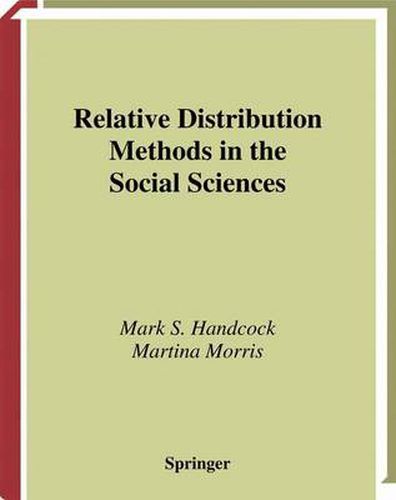Readings Newsletter
Become a Readings Member to make your shopping experience even easier.
Sign in or sign up for free!
You’re not far away from qualifying for FREE standard shipping within Australia
You’ve qualified for FREE standard shipping within Australia
The cart is loading…






This title is printed to order. This book may have been self-published. If so, we cannot guarantee the quality of the content. In the main most books will have gone through the editing process however some may not. We therefore suggest that you be aware of this before ordering this book. If in doubt check either the author or publisher’s details as we are unable to accept any returns unless they are faulty. Please contact us if you have any questions.
In social science research, differences among groups or changes over time are a common focus of study. While means and variances are typically the basis for statistical methods used in this research, the underlying social theory often implies properties of distributions that are not well captured by these summary measures. Examples include the current controversies regarding growing inequality in earnings, racial diferences in test scores, socio-economic correlates of birth outcomes, and the impact of smoking on survival and health. The distributional differences that animate the debates in these fields are complex. They comprise the usual mean-shifts and changes in variance, but also more subtle comparisons of changes in the upper and lower tails of distributions. Survey and census data on such attributes contain a wealth of distributional information, but traditional methods of data analysis leave much of this information untapped. In this monograph, we present methods for full comparative distributional analysis. The methods are based on the relative distribution, a nonparametric complete summary of the information required for scale–invariant comparisons between two distributions. The relative distribution provides a general integrated framework for analysis. It offers a graphical component that simplifies exploratory data analysis and display, a statistically valid basis for the development of hypothesis-driven summary measures, and the potential for decomposition that enables one to examine complex hypotheses regarding the origins of distributional changes within and between groups. The monograph is written for data analysts and those interested in measurement, and it can serve as a textbook for a course on distributional methods. The presentation is application oriented,
$9.00 standard shipping within Australia
FREE standard shipping within Australia for orders over $100.00
Express & International shipping calculated at checkout
This title is printed to order. This book may have been self-published. If so, we cannot guarantee the quality of the content. In the main most books will have gone through the editing process however some may not. We therefore suggest that you be aware of this before ordering this book. If in doubt check either the author or publisher’s details as we are unable to accept any returns unless they are faulty. Please contact us if you have any questions.
In social science research, differences among groups or changes over time are a common focus of study. While means and variances are typically the basis for statistical methods used in this research, the underlying social theory often implies properties of distributions that are not well captured by these summary measures. Examples include the current controversies regarding growing inequality in earnings, racial diferences in test scores, socio-economic correlates of birth outcomes, and the impact of smoking on survival and health. The distributional differences that animate the debates in these fields are complex. They comprise the usual mean-shifts and changes in variance, but also more subtle comparisons of changes in the upper and lower tails of distributions. Survey and census data on such attributes contain a wealth of distributional information, but traditional methods of data analysis leave much of this information untapped. In this monograph, we present methods for full comparative distributional analysis. The methods are based on the relative distribution, a nonparametric complete summary of the information required for scale–invariant comparisons between two distributions. The relative distribution provides a general integrated framework for analysis. It offers a graphical component that simplifies exploratory data analysis and display, a statistically valid basis for the development of hypothesis-driven summary measures, and the potential for decomposition that enables one to examine complex hypotheses regarding the origins of distributional changes within and between groups. The monograph is written for data analysts and those interested in measurement, and it can serve as a textbook for a course on distributional methods. The presentation is application oriented,